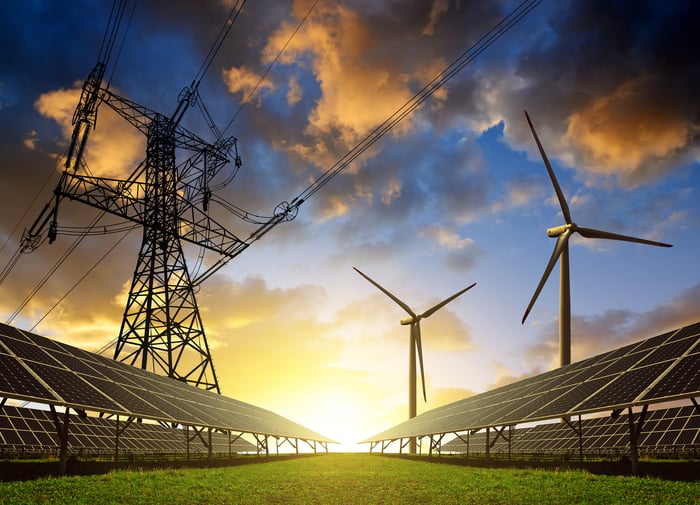TerraForm Power (TERP) has been an abysmal investment since its initial public offering in mid-2014. Investors who bought into the renewable yieldco's IPO hype have seen their investment fall by nearly two-thirds. Driving that value destruction was a series of high-priced, debt-fueled acquisitions aimed at quickly growing the dividend. Instead, TerraForm got in over its head and had to suspend the payout at the end of 2015.
While that checkered past may be enough to make most investors want to avoid TerraForm Power, it's no longer the same company. That's because value-creating juggernaut Brookfield Asset Management (BN 1.59%) bought control of it last year and began making changes. These initiatives have already started paying off for investors and could continue doing so for years to come.
That long-term upside makes it one of the top renewable energy stocks to buy, in my opinion.

Image source: Getty Images.
The bull case for TerraForm Power
TerraForm Power owns a portfolio of wind and solar assets, primarily in the U.S. The company sells the power generated by these facilities to utilities and other end users under long-term contracts, which provides it with relatively steady cash flow. It had retained all that cash flow for the past two years so that it could chip away at its debt. However, thanks to Brookfield's support, the dividend, which currently yields an attractive 6.9%, was recently reinstated.
Over the next five years, TerraForm's goal is to boost that payout at a 5% to 8% annual rate. Fueling growth in the near term is a plan to increase margins by driving down costs. Those initiatives alone position it to raise the payout at a 6% compound annual rate through 2020.
The next phase of the growth strategy will be to reinvest the 15% to 20% of cash flow that TerraForm retains after paying the dividend into organic growth projects such as installing more powerful wind turbines, expanding sites, and adding energy storage. The third leg of the expansion plan is to make value-based acquisitions of renewable assets.
Brookfield believes that, in combination with a nearly 7% dividend yield that it grows at a 5% to 8% yearly pace, should generate a total annual return of around 12%. That gives it the potential to beat the market in the coming years.

Image source: Getty Images.
What could go wrong?
Though Brookfield believes its strategy will create value for TerraForm investors, that entity has already scorched them once. Several factors could cause it to fall short once again. First, TerraForm Power still has an elevated debt level and junk-rated credit, which could impact growth and weigh on the stock price. Brookfield and TerraForm are working on several strategic initiatives to get its balance sheet back up to an investment-grade level, but they have a long road ahead of them made harder now that interest rates have started to rise.
Another concern is that TerraForm has yet to secure the organic expansion projects that will power its next phase of growth. With the company having two wind tower repowering projects in development and time until it will need this growth, it's possible that it won't secure enough projects that meet its strict return hurdles.
Acquisitions comprise the other driver of TerraForm's value-creating growth plan. Despite the company's recent needle-moving deal for a portfolio of wind and solar assets in Spain, it still has to complete a modest number acquisitions in the coming years to give it enough fuel to achieve its five-year dividend growth target. Not only does it need to find deals, but it can't overpay nor use too much debt.
Betting on a team that knows how to create value
Even though TerraForm Power's former parent did nothing but destroy shareholder value, its new one has a history of enriching investors. Brookfield believes it can replicate that success with Terraform by leveraging its existing platform to deliver a high-yielding dividend that it steadily grows over the next five years. If everything goes according to plan, this strategy should power double-digit total annual returns that could beat that market. Any of several risks could hold it back, but the upside potential makes TerraForm Power a good stock to consider, especially for investors looking to add some renewable power to their portfolio.





